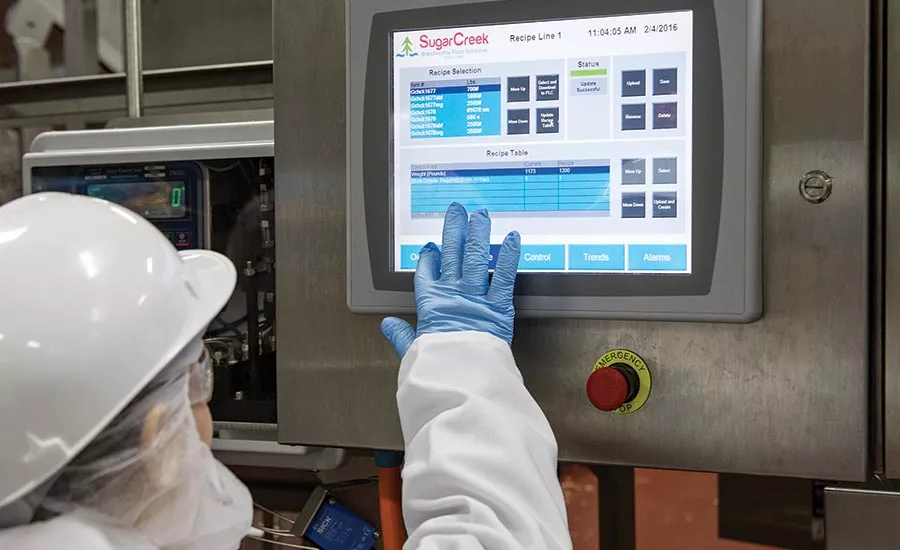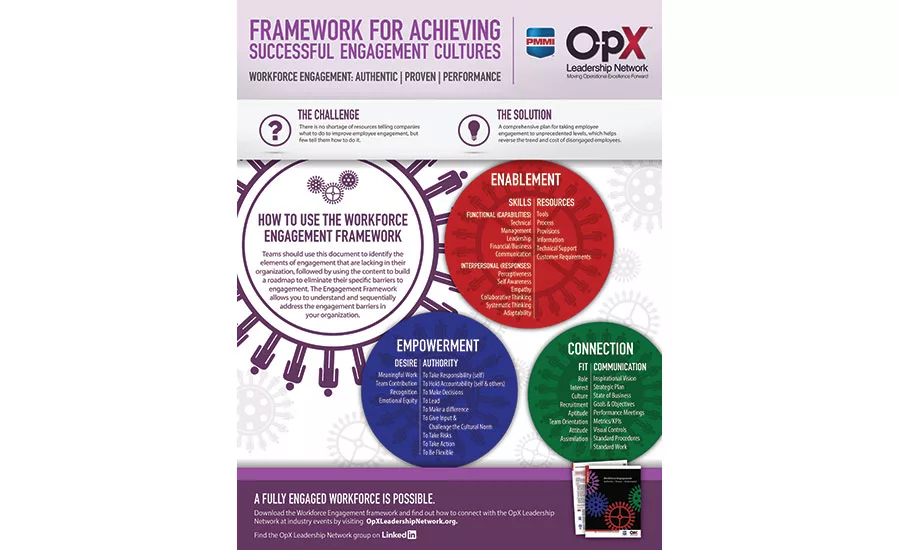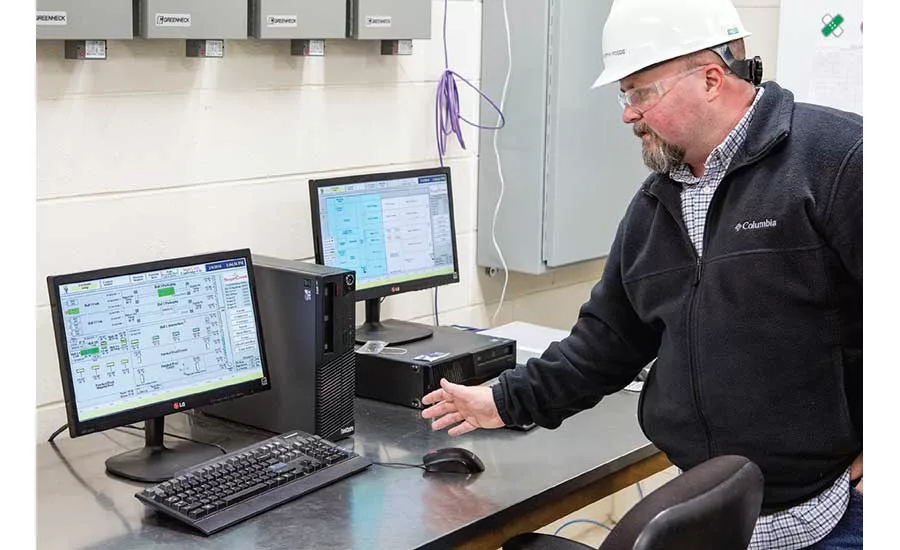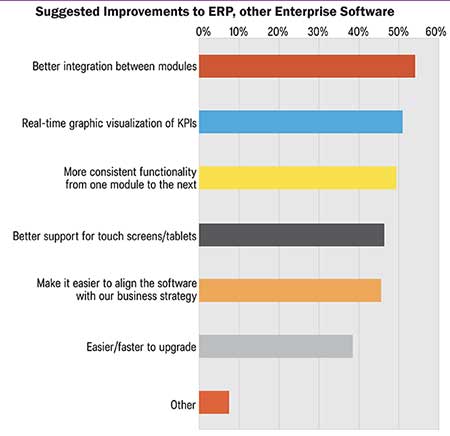Automation Series
Processors use technology to improve employee engagement
New tools are available for processors wanting to connect their workers, but to succeed, companies must have a business plan, transparent communications and a mindset for continuous improvement.

With an engaged workforce, SugarCreek, 2016 FE Plant of the Year, uses technology to empower operators with actionable information to make process decisions at any time.
Photo courtesy of Ross Van Pelt, RVP Photography

For food processors wanting to learn about workforce engagement, the OpX Leadership Network is a great place to get started. Processors can download a manual to learn how to set the foundation for a fully engaged workforce—from operators to senior management. For more information, visit the OpX Leadership Network at www.opxleadershipnetwork.org.
Photo courtesy of OpX Leadership Network

Engaged workers can use smartphones on the plant floor to look at process status.
Photo courtesy of Wayne Labs

Engineers have access to environmental controls anywhere in the plant at SugarCreek via connected devices and with a wireless network, as well tablets or smartphones.
Photo courtesy of Ross Van Pelt, RVP Photography
According to a 2017 Gallup Poll, out of the more than 100 million Americans working full time, only one-third actually like their job. On the other hand, 16 percent of workers are actively disengaged and can be distracting and destructive to the engaged employees. According to Gallup’s Chairman and CEO Jim Clifton, “The remaining 51 percent of employees are not engaged—they’re just there.”
In a 2015 research study, "Mind of the Food Worker," conducted by Alchemy Systems for The Center for Research and Public Policy, the numbers fare a little better for the food industry. Two-thirds of food workers are satisfied in their jobs, but 33 percent of food leaders said their companies were doing a poor job of preparing millennials in the workplace. The same research found that 42 percent of food workers rarely or never receive coaching from their manager/supervisor, and 20 percent of employees said they received too little training before starting the job. Couple this with the finding that 37 percent of workers and 47 percent of supervisors agree that training is sometimes too complicated.
You can throw technology at these problems, such as video-assisted augmented reality (AR); virtual reality (VR) helmets; IIoT-based screens on tablets, phones and watches; KPI (key performance indicator) metrics on handheld devices and giant stat boards; AR-based maintenance systems; fancy HMIs with multiple deep-diving levels … and the list goes on.
However, no matter what tools are employed, without management buy-in on transparent communications from the CEO down to the machine operator and the sanitation worker, not much positive is going to happen in motivating employees or even keeping them in their jobs. Plus, if senior management isn’t interested in continuous improvement, it’s likely the employees won’t be either. And no technology can fix endemic problems.
Article Index:
- Starting on the right foot
- Collaboration tools
- Manufacturing tools: Usability increases engagement
- Data communications: Stay in touch and be engaged
- Hardware tools to engage
- Sidebar: Measuring success and fostering engagement
Starting on the right foot
Before you look at technology solutions to motivate and engage your employees, you need first to evaluate your company’s workplace environment.
“A manufacturer should first take a fact-based, data-driven approach to assessing engagement through surveys and/or interviews of employees to find out what is really going on in their ‘hearts and minds’ before jumping towards solutions to improving employee engagement,” says Tom O’Rourke, president, Connolly Clarke, LLC.
Oftentimes, manufacturers will rely on “gut checks” and not really focus on the root causes of a lack of engagement, which can be obtained through gathering data, adds O’Rourke.
“From our work at Wisconsin Manufacturing Extension Partnership [WMEP] on employee engagement and retention, we have found that having an effective, structured on-boarding process for new employees is critical in getting them engaged right away,” says O’Rourke. This includes establishing effective relationships with their supervisors and colleagues, and setting them up for success.
In addition, assigning cross-functional employee teams to address engagement gaps is an effective method for getting more employees involved and accountable for helping increase overall employee engagement. Some of the best suggestions often come from those closest to the issues and challenges, adds O’Rourke.
“Technology and tools can help improve employee engagement, but there are other factors that play a role,” says Jay Reilly, business development senior manager for ConnectMe, Deloitte Consulting LLP.
It’s important that the HR organization is aligned with the overall business strategy before applying technology solutions. This will help foster better planning and a better understanding of the overall workplace and necessary workforce improvements, from a process, culture and technology standpoint. But don’t expect HR alone to work miracles.
“Employee engagement is not about HR-driven peace offerings or ‘kumbaya’ projects,” says Keith Barr, CEO, Leading2Lean. “We have to change the way people work and give them the personal value for them to truly engage.”
For each employee, that work may be different, but the core elements that affect and motivate are the same. Barr lists these core elements:
- Transparency and engagement by management to see problems employees deal with—and enacting an actionable response to help resolve them
- Connecting the value of the task to a greater purpose—and recognizing employees as they accomplish them
- Communicating truth. Management doesn’t have to challenge, and employees don’t have to defend, but all of them can be focused on how to solve problems with the common purpose of improvement.
Before deploying technology solutions to fix engagement issues, Workify CEO Stephen Huerta suggests that leadership teams should take three simple, but critical, steps. First, come to an agreement that engagement is a key initiative supported by company leadership. Second, establish goals and key outcomes of any future engagement initiatives. Third, make it clear to the organization that management is committed to collecting feedback from employees (positive or negative) and that safe feedback channels will be provided to prevent employee retaliation.
“Employee engagement is as much a cultural challenge as it is a technological one,” says Lilian Bories, former Nestlé executive and now VP marketing at Oblong Industries, Inc.
Only organizations that embrace a commitment to transparency, the availability of data and improvement coming from the base of the organization will be able to improve workforce engagement in a manufacturing facility. Six Sigma and Lean Sigma are examples of well-known philosophies and management principles based on this approach.
Once that commitment is clear, then technology plays a critical role to make it happen at the operational level, adds Bories. The ability to share and view any type of data seamlessly—more of which is coming with IIoT—allows all the participants to analyze problems more deeply, with the right information, regardless of form factor. In other words, as Bories says, “Engagement improves when all the critical information is available to analyze performance, understand problems and find solutions.”
Getting things in perfect balance often requires a little fine-tuning.
“We have found that a delicate mix of management support, management spearheading, employee initiative and ‘employee lead development’ to be key,” says David Lewis, Sierra Nevada Brewing Company senior design services engineer III. “There are two levels of management in play in these instances—plant level (and higher) and department level. If plant level (and higher) has little interest, but employees and department level managers are on board, then we simply plow ahead. If plant level (and higher) is pushing, but the lower levels are not on board, then we tend to stand back and demonstrate there is a mismatch between management expectations and operations level management/employees.”
Collaboration tools
Software tools can be divided into two general categories: collaboration and manufacturing, with the latter including, for example, ERP, LIMS, MES, MOM, etc. However, there’s one important thing to keep in mind about any tools you select: They need to adapt to change.
Collaboration tools can help prevent management problems, such as receiving negative comments on social media sites that include criticisms regarding “poor management” or “management that doesn’t listen.” Better to find out in house what the issues are rather than hearing about them in an exit interview or reading about them online.
“Overall, we are seeing a shift from siloed, hierarchical workplaces to a focus on collaboration, working in teams and non-linear movement throughout an organization,” says Deloitte’s Reilly.
This shift allows for flexibility and agility—and there is a plethora of new solutions that promote and support it. For example, digital tools like Deloitte’s ConnectMe can facilitate easy digital communication flow between employees, HR and managers, while also increasing collaboration and communication through social networking tools that allow employees to network at work as they do in their personal lives, connecting with people across divisions and geographies.
These technology solutions open up communication and collaboration within organizations and help improve employee engagement by making employees—including remote and part-time workers—feel like part of a community, adds Reilly. It gives them a choice in a way that is convenient and closely aligned to how they use technology in their personal lives. Being able to communicate with colleagues and managers at the click of the button takes less time than sending emails and trying to track down the right people and scheduling meetings—and allows for a quick, agile, community-style form of communication.
Ezassi is a set of software solutions that provides a range of applications that can be used to drive employee engagement and collaboration in a manufacturing or plant setting. This cloud-based solution can be accessed from desktop browsers or through mobile devices and can be used to collect employee input on improving manufacturing processes—or any other area that improves the workplace environment. These solutions, according to Virginia Bush, director of marketing and product development at Ezassi, can provide a sense of ownership to employees and provide a direct line of communications to management.
“There are a variety of technology solutions that can help solve communications issues,” says Workify’s Huerta.
From peer-to-peer messaging applications to suggestion boxes and employee surveys, there are many ways to remedy communication issues. Most companies fail at digging deep to understand the root of communication issues and, as a result, implement more technology solutions before truly understanding the issue.
“We recommend that before jumping to solutions that you spend some time assessing the real challenge,” says Huerta.
Speaking specifically to the challenge of improving communication between team members and management, Workify allows employees to provide anonymous feedback at different stages of the employee experience: new hire surveys, quarterly engagement surveys, leadership surveys and exit surveys, adds Huerta. The software also has an on-demand suggestion box that enables a two-way conversation between employees and management.
Oblong Industries’ Mezzanine is a collaboration solution that scales and flexes for the team and the workplace, according to Bories. It is, at its core, a software solution that drives meeting room hardware to perform in the most intuitive, useful and engaging way. The system fluidly delivers streams of content contributed from collaborators’ laptops or other data sources to a shared digital workspace simultaneously. A gestural interface is among the modes of controlling the location and scale of these content streams to better organize the information based on the challenge that needs to be solved through a collaborative approach.
Leading2Lean LES has a host of available tools, all of which help team members communicate among themselves and with management, says Barr. The fully transparent system allows all employees to see processes, problems and solutions in real time as they happen. This means problems are identified and solved quickly, and downtime is drastically reduced. In addition, Barr reports that recently implemented Kaizen and Yokoten enhancements improve system-wide sharing of best practices—and provide insights to how manufacturers can continually improve plant or plant network performance. Kaizen is a revitalized “suggestion box,” making it easy for employees to submit ideas for system improvement in real time, and Yokoten is the ability to share improvements across a company’s factory, from plant floor to C-suite, or across multiple global factories.
Manufacturing tools: Usability increases engagement
According to the aforementioned Mind of the Food Worker survey, younger workers—especially millennials—prefer digital training methods over traditional instructor-led training. The study showed that food workers respond better to more frequent training communication—a need that is filled by digital technologies. Training is enhanced by digital AR/VR video systems, and younger YouTube users expect this level of sophistication.
Another key issue has to do with user experience, especially when employees who most likely own more advanced personal devices and software than what is at their workplace. Manufacturers using out-of-date systems that are command line driven or counterintuitive will find themselves at a disadvantage in recruiting and keeping workers.
“Usability has a direct link to employee retention,” says Charles Rathmann, senior marketing communications analyst, North America, IFS.
Intuitive and usable systems engage people. If a food and beverage manufacturer wants to realize the benefits of digital transformation, it needs enterprise software that employees find simple—and effective—to use.
The latest IFS industry study on employee engagement points out some alarming results for employee retention based on software usability. The study found, on average, 26 percent of respondents said they were either definitely or somewhat likely to change jobs over poor software usability—an average that tended to increase based on age. Some 45 percent of 36- to 45-year-olds and 33 percent of both 46- to 55-year-olds and 56-plus categories said they were definitely or somewhat likely to change jobs over poor software usability. With the younger demographics, the 18- to 35-year-olds, only 26 percent said they are definitely or somewhat likely to change jobs over poor software usability. However, the numbers clearly show that software usability is a significant factor in engaging and retaining employees.
Highly usable enterprise software is key if the benefits of digital transformation are to be seen. We should assume that all employees are professional, ambitious people and demand usable, agile software that helps, rather than hinders, their work, adds Rathmann.
What happens when ERP software isn’t so easy to use?
“In situations where enterprise software usability was poor,” says Rathmann, “88 percent [of those polled in the study] said they would be likely to use spreadsheets instead of their ERP system, with 84 percent citing Microsoft Excel.”
Can Excel provide the necessary visibility to govern a large business with a set of accurate, trusted management information? Not likely. For example, many processors have PLM and LIMS where data needs to connect to the ERP system to provide non-siloed information to whichever person needs it.
An ERP system enables processors to bridge the gap between various installed business systems, such as PLM, LIMS, SCM and CRM, says Mike Edgett, Infor industry & solution strategy director, process manufacturing.
“What we are seeing is a growing adoption of cloud suites, which are more than just an ERP, but a flexible cloud-based collection of pre-integrated solutions with an overriding collaborative platform,” he says. “This enables companies to not only improve engagement across the business, but provides a more scalable approach.”
At the shop floor level, Factora plans, designs and implements manufacturing execution systems (MESs) and manufacturing operations management (MOM) solutions.
“As an independent solution provider, primarily we are involved in the area of user experience [UX]—improving how employees engage with their current systems, done by implementing new technology to open up new areas of engagement, improve productivity and simplify how employees engage,” says Barry Lynch, VP sales & marketing.
Prior to going live with a custom-designed MES or MOM application for a manufacturer, Factora finds that engagement with the whole community of workers at a facility is a must. Lynch notes four approaches Factora takes towards any new IIoT implementation:
- Discovery session with the C-suite to determine the possible business opportunity—determine the team champions.
- Workshop on site to build the employee engagement from the ground up and validate the right place to start the journey to get the business opportunity value.
- Short pilot (proof of value) to prove the case based on the output of the workshop and have team members involved in crafting the final UX.
- Develop a programmatic approach to implement the correct IIoT technology across the business based on the findings of the proof of value, and have team champions as part of that decision.
Factora also focuses on change management processes to enable a successful outcome for the project. This includes awareness, risk identification and mitigation, training, go-live readiness, hypercare support and handover to the support team. The software provider has always maintained that technology itself does not produce desired outcomes, and end-user engagement throughout the lifecycle of the project is crucial.

Data communications: Stay in touch and be engaged
In terms of communications, Factora has a built-in chat capability (wiki) that has been used quite successfully to foster communications and engagement among users. Lynch has also seen many companies use collaboration tools, such as Microsoft Sharepoint, to store key procedures, root cause analyses, solutions for operational problems, etc.
The extent to which software can bring data together in real time and allow users to make informed and educated decisions is a testimony to how well a system fosters communications on the plant floor level and to higher-level business systems.
“I’ll state up front that we are users of [Inductive Automation’s] Ignition,” says Sierra Nevada Brewing’s David Lewis. “It is our primary software platform for all MES, QA, LIMS, production tracking, reporting, etc. functions. We’ve built extensive data collection interfaces that operate with some combination of manual, direct connection to machines/lab devices, mobile and desktop technologies.
“We combine real-time operational data with analytical testing data, production metadata [and] product metadata [specifications, etc.] to provide real-time dashboards for OEE and QA. We use the same technologies and data to manage workflows and integrate our various other business systems [order management, production scheduling, WMS, ERP, etc.],” adds Lewis.
“When employees have access to shared data, it can be used to bring attention to existing problems and even to potential trouble areas before they escalate,” says Melissa Topp, ICONICS senior director of global marketing.
Shared data can also be used to facilitate recognition of top performers in a given location, product line or process, so those employees benefit from positive reinforcement. Other employees can benefit from the knowledge/information sharing itself in terms of best practices and lessons learned.
Engagement can increase when employees are assured that the same data is available throughout an organization (from machine operator to CEO), and concerns that may have previously seemed subjective can now be viewed more objectively, says Topp.
Transparency and real-time monitoring provide incentives beyond normal management principles, says Leading2Lean’s Barr. Keeping people accountable for their work drives the tasks’ importance and makes people feel valued. Having this transparency assures that management sees and acknowledges the things employees are dealing with and the value of their contribution. Feeling valued every day creates a very different level of personal engagement. And on the management side, the staff is able to see the real issues employees deal with versus being hidden in the work. Management is on the same page, and there’s more value placed on the employee’s work.
Hardware tools to engage
Whatever the hardware or software tools you use to engage operators, remember the key to success is the solution itself—not the technology, says Sierra Nevada Brewing’s Lewis.
“There are obvious caveats—such as whether or not data is available [real-time process data, etc.], to what degree the data can be combined and blended, etc. But if all those boxes are checked, many technologies can be used to create a solution.”
“Dashboards that communicate goals and progress can be effective communications tools,” says Peg Dorn, food consultant/manufacturing specialist, Wisconsin Manufacturing Extension Partnership.
Computers in breakrooms showing what the goals are and how they are tracking can be effective motivational tools. Dashboards on computers, tablets and smartphones can provide constant communication to all employees.
Multiple technological tools can help engage an organization’s employees towards manufacturing process improvement, says ICONICS’ Topp. Anecdotally, it seems that employee buy-in is higher when an organization keeps step with up-to-date technology. Automation software has seen a steady evolution from command-line-driven interfaces to rudimentary 2-D screens to photo-realistic 3-D representations of machinery (often with video for maintenance people). Fast forward to recent times with the emergence of mobile devices, and now, augmented reality with heads-up displays can provide the situation-specific KPIs needed for each employee’s role and responsibilities.
Much like Lewis’s first comment, Topp suggests that the “wow factor” is certainly a draw for many employees within a manufacturing environment, but it doesn’t lead to sustained use if the fundamentals aren’t followed. There will still need to be clear delineation of roles/responsibilities and transparency of how data gets dispersed through an organization, along with what incentives are being offered to reward improving overall performance KPIs.
Monitoring KPIs alone is essential, though highly insufficient to help engagement, says Oblong Industries’ Bories. The best technology tools must enable the creative momentum of the group to flourish to improve performance where the monitoring of KPIs has signaled opportunities. Bringing together multiple sources of data and content seamlessly then becomes critical to engage the group in finding more innovative solutions as a group.
Measuring success and fostering engagement >>
For more information:
Connolly Clarke, LLC, www.connollyclarke.com
Deloitte Consulting LLP, http://tinyurl.com/y8bppkwe
IFS NA, www.ifsworld.com
Leading2Lean, www.leading2lean.com
Workify, www.getworkify.com
Oblong Industries Inc., www.oblong.com
Ezassi, www.ezassi.com
Factora, www.factorasolutions.com
ICONICS, www.iconics.com
Wisconsin Manufacturing Extension Partnership, www.wmep.org
Infor, www.infor.com
The OpX Leadership Network, Workforce Engagement, www.opxleadershipnetwork.org/workforce-development-engagement
Looking for a reprint of this article?
From high-res PDFs to custom plaques, order your copy today!








